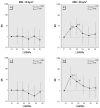Low dose of some persistent organic pollutants predicts type 2 diabetes: a nested case-control study
- PMID: 20444671
- PMCID: PMC2944083
- DOI: 10.1289/ehp.0901480
Low dose of some persistent organic pollutants predicts type 2 diabetes: a nested case-control study
Abstract
Background: Low doses of some persistent organic pollutants (POPs) associate cross-sectionally with type 2 diabetes, whereas associations with high POP exposures are inconsistent.
Objectives: We investigated whether several POPs prospectively predict type 2 diabetes within the Coronary Artery Risk Development in Young Adults (CARDIA) cohort.
Methods: Participants in this nested case-control study were diabetes free in 1987-1988. By 2005-2006, the 90 controls remained free of diabetes, whereas the 90 cases developed diabetes. Using serum collected in 1987-1988, we measured 8 organochlorine pesticides, 22 polychlorinated biphenyl congeners (PCBs), and 1 polybrominated biphenyl (PBB). We compared POP concentrations from CARDIA and the National Health and Nutrition Examination Survey (NHANES) in 2003-2004. We computed odds ratios (ORs) for incident diabetes using logistic regression analysis.
Results: Chlorinated POPs in CARDIA in 1987-1988 were much higher than corresponding NHANES 2003-2004 concentrations. POPs showed nonlinear associations with diabetes risk. The highest risk was observed in the second quartiles of trans-nonachlor, oxychlordane, mirex, highly chlorinated PCBs, and PBB153-a finding that suggests low-dose effects. We concentrated risk by summing these POPs and isolated very low concentrations of multiple POPs in the lowest sextile of the sum. The adjusted OR in the second sextile vs. the lowest sextile was 5.3 overall and 20.1 for body mass index > or = 30 kg/m2.
Conclusions: Several POPs at low doses similar to current exposure levels may increase diabetes risk, possibly through endocrine disruption. Certain POPs may a play a role in the current epidemic of diabetes, which has been attributed to obesity.
Figures


Similar articles
-
Polychlorinated biphenyls and organochlorine pesticides in plasma predict development of type 2 diabetes in the elderly: the prospective investigation of the vasculature in Uppsala Seniors (PIVUS) study.Diabetes Care. 2011 Aug;34(8):1778-84. doi: 10.2337/dc10-2116. Epub 2011 Jun 23. Diabetes Care. 2011. PMID: 21700918 Free PMC article.
-
Low dose organochlorine pesticides and polychlorinated biphenyls predict obesity, dyslipidemia, and insulin resistance among people free of diabetes.PLoS One. 2011 Jan 26;6(1):e15977. doi: 10.1371/journal.pone.0015977. PLoS One. 2011. PMID: 21298090 Free PMC article.
-
Association between serum concentrations of persistent organic pollutants and insulin resistance among nondiabetic adults: results from the National Health and Nutrition Examination Survey 1999-2002.Diabetes Care. 2007 Mar;30(3):622-8. doi: 10.2337/dc06-2190. Diabetes Care. 2007. PMID: 17327331
-
A strong dose-response relation between serum concentrations of persistent organic pollutants and diabetes: results from the National Health and Examination Survey 1999-2002.Diabetes Care. 2006 Jul;29(7):1638-44. doi: 10.2337/dc06-0543. Diabetes Care. 2006. PMID: 16801591
-
Chlorinated persistent organic pollutants, obesity, and type 2 diabetes.Endocr Rev. 2014 Aug;35(4):557-601. doi: 10.1210/er.2013-1084. Epub 2014 Jan 31. Endocr Rev. 2014. PMID: 24483949 Free PMC article. Review.
Cited by
-
Organochlorine insecticides induce NADPH oxidase-dependent reactive oxygen species in human monocytic cells via phospholipase A2/arachidonic acid.Chem Res Toxicol. 2015 Apr 20;28(4):570-84. doi: 10.1021/tx500323h. Epub 2015 Feb 11. Chem Res Toxicol. 2015. PMID: 25633958 Free PMC article.
-
Changes in persistent organic pollutant levels from adolescence to young adulthood.Environ Res. 2015 Jul;140:214-24. doi: 10.1016/j.envres.2015.03.009. Epub 2015 Apr 10. Environ Res. 2015. PMID: 25863595 Free PMC article.
-
Persistent organic pollutants and obesity-related metabolic dysfunction: focusing on type 2 diabetes.Epidemiol Health. 2012;34:e2012002. doi: 10.4178/epih/e2012002. Epub 2012 Jan 27. Epidemiol Health. 2012. PMID: 22323980 Free PMC article.
-
Type 2 Diabetes Mellitus and Alzheimer's Disease: Overlapping Biologic Mechanisms and Environmental Risk Factors.Curr Environ Health Rep. 2018 Mar;5(1):44-58. doi: 10.1007/s40572-018-0176-1. Curr Environ Health Rep. 2018. PMID: 29464502 Free PMC article. Review.
-
Polychlorinated biphenyls and organochlorine pesticides in plasma predict development of type 2 diabetes in the elderly: the prospective investigation of the vasculature in Uppsala Seniors (PIVUS) study.Diabetes Care. 2011 Aug;34(8):1778-84. doi: 10.2337/dc10-2116. Epub 2011 Jun 23. Diabetes Care. 2011. PMID: 21700918 Free PMC article.
References
-
- Centers for Disease Control and Prevention (CDC) National Health and Nutrition Examination Survey: NHANES 2003–2004. 2010. [[accessed 20 July 2010]]. Available: http://www.cdc.gov/nchs/nhanes/nhanes2003-2004/nhanes03_04.htm.
-
- Daston GP, Cook JC, Kavlock RJ. Uncertainties for endocrine disrupters: our view on progress. Toxicol Sci. 2003;74(2):245–252. - PubMed
-
- Friedman GD, Cutter GR, Donahue RP, Hughes GH, Hulley SB, Jacobs DR, Jr, et al. CARDIA: study design, recruitment, and some characteristics of the examined subjects. J Clin Epidemiol. 1988;41(11):1105–1116. - PubMed
-
- Henriksen GL, Ketchum NS, Michalek JE, Swaby JA. Serum dioxin and diabetes mellitus in veterans of Operation Ranch Hand. Epidemiology. 1997;8(3):252–258. - PubMed
-
- Howard BV. Insulin resistance and lipid metabolism. Am J Cardiol. 1999;84(1A):28J–32J. - PubMed
Publication types
MeSH terms
Substances
Grants and funding
- N01 HC095095/HL/NHLBI NIH HHS/United States
- N01 HC048048/HL/NHLBI NIH HHS/United States
- R01 HL053560/HL/NHLBI NIH HHS/United States
- N01-HC-48047/HC/NHLBI NIH HHS/United States
- N01-HC-95095/HC/NHLBI NIH HHS/United States
- N01-HC-48050/HC/NHLBI NIH HHS/United States
- N01-HC-48049/HC/NHLBI NIH HHS/United States
- N01 HC048047/HL/NHLBI NIH HHS/United States
- N01 HC048050/HL/NHLBI NIH HHS/United States
- N01-HC-48048/HC/NHLBI NIH HHS/United States
- R01-HL-53560/HL/NHLBI NIH HHS/United States
- N01 HC048049/HL/NHLBI NIH HHS/United States
LinkOut - more resources
Full Text Sources
Medical

